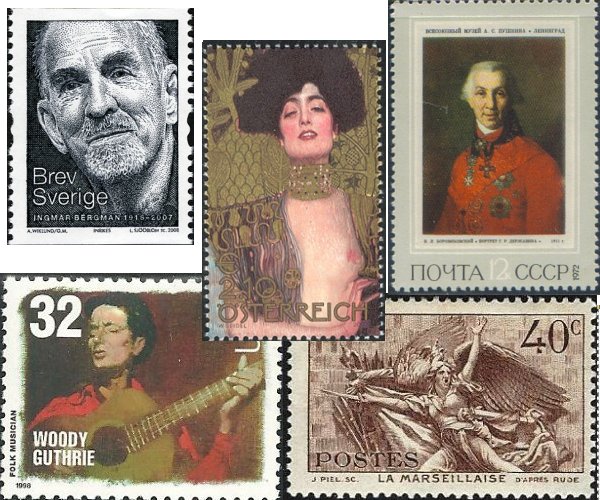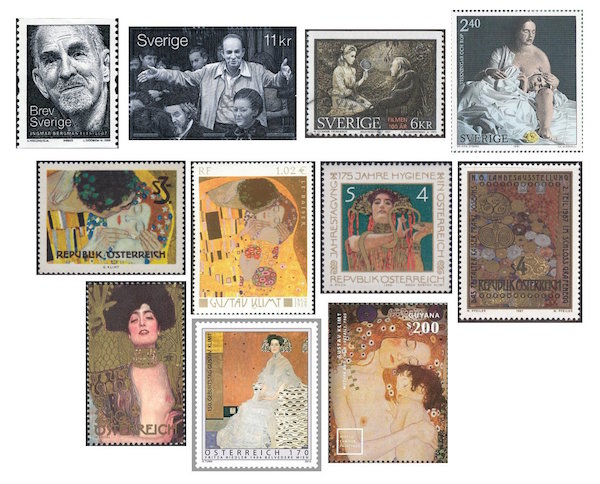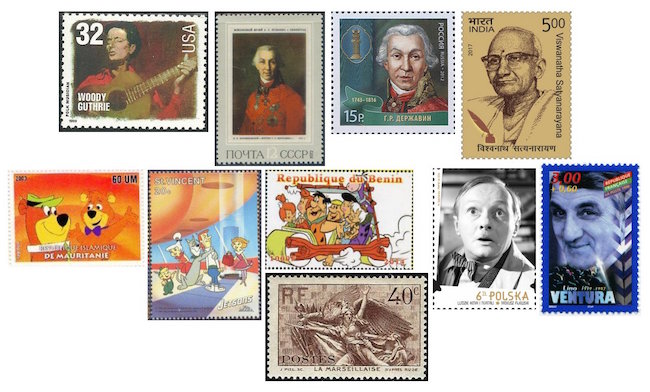The Arts on Stamps of the World — July 14
An Arts Fuse regular feature: the arts on stamps of the world.

By Doug Briscoe
After yesterday’s gargantuan Arts Blast, it’s nice to kick back with just three towering arts figures: Ingmar Bergman, Gustav Klimt, and Woody Guthrie. No slight intended to the other five people we’ll be visiting with today: two poets, a famed American animator, and two 20th-century European actors not well known in the U.S.
So we begin and end with the European film industry today, and no better place to start than right at the top. Ingmar Bergman (14 July 1918 – 30 July 2007) and his work have been celebrated on four Swedish stamps, two of them from 2008, the year after his death. The other two were from commemorative sets of Swedish film, with stills from Wild Strawberries (1957) and Cries and Whispers (1972).
Austria’s native son Gustav Klimt (July 14, 1862 – February 6, 1918) has had his work displayed on no fewer than five separate Austrian issues, the earliest from 1964. That one, showing a detail from one of Klimt’s most familiar pieces, The Kiss (1907-08), came out in recognition of the reopening of the Vienna Secession Museum. (The same painting appears on France’s 2002 stamp from its ongoing arts series.) The occasion for the 1980 stamp showing a detail from Hygeia (or Medicine, 1900-07) was, according to my Scott catalogue, the 175th anniversary of the “academic teaching of hygiene.” This piece came from a set of three intended for the ceiling of the Great Hall at the University of Vienna, though in the event the paintings were deemed too suggestive and never displayed there. Much sadder, SS barbarians intentionally destroyed all three works in May 1945. The curious 1987 design offers up just a tiny detail taken from the Portrait of Adele Bloch-Bauer I (1903-07), a snippet drawn from the right side of Bloch-Bauer’s head. The purpose of this stamp was to mark a currently running exhibition called The Era of Emperor Franz Joseph. Finally, in 2003, a stamp actually intended to remember Klimt himself, specifically the 85th anniv of his death, was issued. It is of Klimt’s iconic Judith and the Head of Holofernes (1901). The most recent Austrian Klimt stamp, for his sesquicentennial, shows Portrait of Fritza Riedler (1906), and I chose just one item from the numerous souvenir sheets that can be had from such countries as (the usual suspects) Mozambique, Togo, the Central African Republic, Niger, the Solomon Islands, Sierra Leone, and the Maldives. This one, from Guyana, gives us the exquisite Mother and Child (1905).

Woody Guthrie (July 14, 1912 – October 3, 1967) is one of the foremost names in American folk music and was a tireless Fighter of the Good Fight. He was named for Woodrow Wilson (as were two of my uncles: Woodrow “Doody” Brownell, who was killed by a streetcar when he was nine, decades before I was born, and Marcus Woodrow Brownell, born 1922, who did time in the joint for armed robbery). Woody was an “Okie” from the Dust Bowl who packed up with his family and went to California, where he worked in radio, became friendly with Will Geer and John Steinbeck, and started writing songs. He flirted and sympathized with Communism but was never a card-carrying party member. He wrote “This Land Is Your Land” in 1940 because he felt that “God Bless America” got too much airplay. During World War II he served in the Merchant Marine and was torpedoed. A novel Guthrie wrote in 1947, House of Earth, was published only in 2013. His later years were plagued by Huntington’s disease. Since 1998, the Woody Guthrie Folk Festival has been held at this time of year in his hometown of Okemah, Oklahoma.
Gavrila Derzhavin (14 July 1743 – 20 July 1816) was in the military and then the civil service until he was sixty, even working as Catherine the Great’s personal secretary for a time. His poetry, which eschewed established norms and was often mockingly playful, consisted of odes, idylls, and anacreontic verse. Alas, he also wrote an anti-Semitic screed that included suggestions later put into effect by Tsar Alexander I.
The Indian (Telugu) poet Garimella Satyanarayana (14 July 1893 – 18 December 1952) resisted the Raj, one of his songs earning him a year in jail in 1922, one of a number of occasions when he suffered imprisonment for his politics. His most famous song was “We don’t need this white rule”. He lived and died in poverty.

William Denby “Bill” Hanna (July 14, 1910 – March 22, 2001) and Joseph Barbera met at MGM in 1937. They began collaborating right away, but didn’t form Hanna-Barbera until twenty years later. In addition to drawing and animating, Hanna did some of the voices, though I couldn’t find out which characters he portrayed. For Barbera’s birthday I offered up a Dutch Flintstones stamp and an Albanian Tom and Jerry. Today we see a Yogi Bear from Mauritania, a Jetsons from St. Vincent, and a Flintstones from Benin.
Polish stage and film actor Tadeusz Fijewski (ta-DAY-oosh fih-YEF-ski; 14 July 1911 – 12 November 1978) trod the boards from the age of ten in his native Warsaw. After the invasion of Poland he was held for five months at Sachsenhausen before being moved to Dachau, finally being released from “protective custody” five days after his 30th birthday in 1941. He was able to resume work as an actor almost immediately after the war. He appeared in fifty films in as many years, 1927-1978, and did some television work from 1966.
Italian-born movie actor Lino Ventura (14 July 1919 – 22 October 1987) grew up in Paris and was a great favorite among French moviegoers. In his youth he was a prizefighter and wrestler, which perhaps contributed to his type-casting as a tough guy on either side of the law. During the war he was compelled to serve in the Italian army but deserted on principle. Venturi worked in film from 1953 to the year of his death, but appeared in only a few Italian language films and spoke with a French accent. (He did appear in a few English language pictures.) Yet he never gave up his Italian citizenship.
So it seems fitting that we should wind up on this Bastille Day with a stamp for the Marseillaise.
A graduate of the University of Massachusetts with a B.A. in English, Doug Briscoe worked in Boston classical music radio, at WCRB, WGBH, and WBUR, for about 25 years, beginning in 1977. He has the curious distinction of having succeeded Robert J. Lurtsema twice, first as host of WGBH’s weekday morning classical music program in 1993, then as host of the weekend program when Robert J.’s health failed in 2000. Doug also wrote liner notes for several of the late Gunther Schuller’s GM Recordings releases as well as program notes for the Boston Classical Orchestra. For the past few years he’s been posting a Facebook “blog” of classical music on stamps of the world, which has now been expanded to encompass all the arts for The Arts Fuse.
